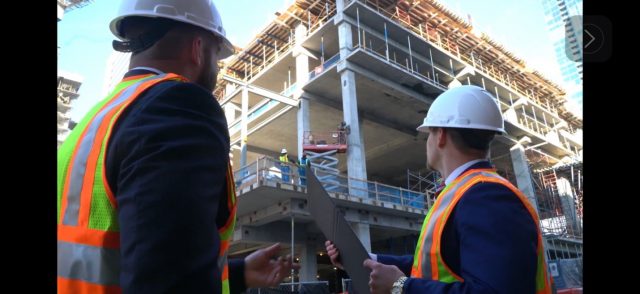“Physical assets like commercial real estate will hold more value in the middle of economic turmoil than stocks, bonds, and mutual funds”, says Lubbock CEO of Boron Capital, Blake Templeton.
Boron Capital is a real estate investment firm that specializes in commercial real estate such as self-storage complexes, mobile home parks, and corporate housing, and they have focused largely on tangibles for a reason. In addition to the importance of investing in something timeless that doesn’t depend on trends, Blake notes that it doesn’t take an economist to realize that wading into the stock market, especially now, is a dangerous game. So many people are afraid to even check the balances on their online trading accounts and college funds and are now considering alternative investment strategies that don’t evaporate overnight. Something more…tangible.
Tangible assets are physical. They hold value. They can be destroyed but only by natural disasters, accidents, or fires, and they usually carry some form of insurance against such a catastrophe. From rental properties to equipment to plants, consumers as well as businesses can hold many different types of tangible assets at any given time.
Inversely, intangible assets do not possess a physical form. For businesses, intangibles can still have tangible value, because they are directly connected to the business and can produce cash flow. These include things like trademarks, patents, goodwill, brand recognition, business methodologies, copyrights, and intellectual property. For consumers however, intangibles are investments like stocks, bonds, and ETFs, where the consumer is not directly connected to the assets, due to the stock market being a second-hand market.
While both asset types have merit in a business context, Blake Templeton reports that tangible assets are the far superior investment class when it comes to investors, because this is the only way they can be directly tied to the assets.
When it comes to the world of tangibles, it’s helpful to understand the basic classifications and valuation methods that owners employ, to begin developing the understanding necessary to acquire investments that retain their value.
The Two Broad Types of Tangible Assets
Boron Capital’s Lubbock CEO explains that tangible assets are split into two categories:
Current Assets
Current assets, otherwise known as liquid assets, can easily be exchanged for cash and are only held by a business for a short time (typically less than one year).
Cash, accounts receivable, business inventory, short-term investments, and cash equivalents are all current assets, and they possess greater liquidity than their fixed counterparts.
Even though they may not have an onsite presence, they do carry transactional value.
Fixed Assets
Companies hold hard assets for long periods, and they cannot easily convert them into cash, however the asset itself routinely produces cash flow, which is much more valuable than static cash that inflation can whittle away. According to Templeton, assets depreciate over time (which can be used to the investor’s benefit) and include items like:
- Buildings — They’re the most obvious tangible asset type, encompassing warehouses, self-storage complexes, office parks, corporate housing, apartments, and other kinds of commercial real estate. Any improvements a business makes to a building are likely types of tangible assets too.
- Machinery and computer equipment — Any manufacturing or heavy-lifting machinery or equipment used to process inventory fall under the fixed tangible asset category. Preparation, manufacturing, assembly, and QC production line equipment are all included.
- Land — Whether the land is being held for future redevelopment, speculative growth, or yet-to-be-determined plans, it counts as a tangible asset. Businesses cannot call digital land ownership (i.e., space owned within the metaverse) tangible assets because the real estate cannot be physically touched.
- Furniture and fixtures — Everything inside a commercial building can be considered tangible assets, including desks, visitor-dedicated furniture, meeting room components, and everything in between.
Blake Templeton Explains the Characteristics of Tangible Assets
Businesses can class an item as a tangible asset if it meets the following characteristics:
- Physical form — The object has a physical form, meaning it can be felt, touched, or seen.
- Depreciation — The item’s value could depreciate over time as its condition declines over the life of the asset.
- Residual value — It holds residual value. In other words, it will sell for a to-be-determined amount once the object’s useful lifespan has culminated.
- Collateral — The physical asset is recognized as sustainable and therefore can be collateral to acquire loans.
- Daily operations — The business physically uses the objects to benefit its financial climate or perform daily operational tasks.
The Importance of Tangible Assets for Investments
“Tangible assets are what run the stability of the American economy. And depreciation can actually be a good thing since it’s a non-cash expenditure, meaning the company or individual holding a property receives a tax benefit without declining cash flow,” explains Blake Templeton of Boron Capital.
The consistency of cash flow is a major differentiator of commercial real estate against the stock market’s iconic highs and even lower lows. Tangible property acts as a hedge against inflation because when the value of the dollar goes down, in essence the value of the real estate goes up because it takes more dollars to buy the real estate. With depreciation, cash flow, and a hedge of inflation, you can see how tangible assets greatly benefit the investor.
 The Best Method of Valuing Tangible Assets
The Best Method of Valuing Tangible Assets
Boron Capital’s Lubbock CEO notes that tangible assets can be valued in different ways, but the quality, demand, and uniqueness tend to dictate its value.
The Appraisal
In a commercial appraisal, the business hires a professional appraiser to figure out the true fair market value of the asset. When there is a business component included with the physical asset, there is a blended value created through a discounted cash flow, cap rate, and revenue multiple.
Discounted Cash Flow Method
Discounted cash flow (DCF) estimates the value of an investment using its expected future cash flows. DCF valuation method focuses on determining the value of an investment today, based on projections of how much money that investment will generate in the future.
Cap Rate Method
The cap rate is a metric that represents the yield of an investment that was purchased with cash. This is based on a 1 year time frame and is a percentage earned per year on the cash used for the purchase. The capitalization rate is the unleveraged rate of return. Using the industry standard cap rate comparable to the specific asset, with the 3-5 year pro forma cash flow of a new business or the actual cash flow of a stabilized business, you can come to a reasonable value.
Revenue Multiple
The revenue multiple is a valuation metric used to value an investment by using comparable or like properties and dividing their sold price by their gross revenue. This gives you a metric that would say, based on the pro forma gross revenue of a new business or the actual gross revenue of a stabilized business, you could use an averaged revenue multiple for that industry and multiply it by the gross revenue of the subject investment to find a value.
The cost basis of the investment is taken into consideration especially when the property is newly built, however there is also value in the business that is newly created or fully established and these 3 types of valuation, when blended, create the most accurate value of the property.
Tangible Assets are More Appealing than Ever to Both Individuals and Businesses
“Investing in commercial real estate and businesses is one of the most prudent strategies when it comes to sustaining your wealth in a world full of financial turmoil,” says Blake Templeton of Boron Capital.
Everyone needs to diversify out of the stock market and own tangible real estate for cash flow, tax advantages and value sustainability.








